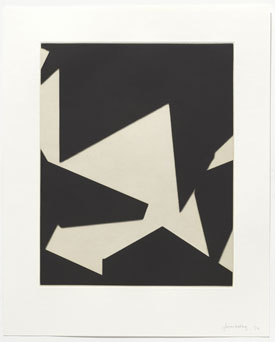3.18.24 — A Handful of Dust
Gabriel Orozco will show you art in a handful of dust. It is a rebuke to traditional art forms all the same, with a little help from Jacob Samuel.
Dust is a space, but not a landscape. Orozco makes that clear on the opening page of a series of prints. So what if it, too, is a work of art? Samuel, a printmaker in Santa Monica, has worked with some sixty leading artists over more than thirty years. Many of them would otherwise have refused to enter any space that reeks of fine art. That includes the space of “Jacob Samuel and Contemporary Etching,” at MoMA through March 23. 
What kind of print is right for modern and contemporary art? It could be lithographs for their relative ease of making—and for a poster style going back to Henri de Toulouse-Lautrec. It could be silkscreens, for the world after Andy Warhol, or monoprints, where anything goes. For Max Beckmann and German Expressionism, it could be woodcuts, with thick, jagged outlines that speak of a crude past and a still harsher modern world. But no, for Samuel favors a medium as disciplined as etching. He took it up in the late 1980s in the studio of Sam Francis, the abstract painter, and has been seeking collaborators ever since.
In etching, the artist makes incisions, akin to freehand drawing, in a protective layer over a metal plate. An acid batch then penetrates the incisions, leaving its cuts in the plate. Wipe away the protective layer, brush ink over the plate, wash away all but what has found its way into the cuts, press the plate against paper, run them through a printing press, and (voilà) you have an etching. Each of Samuel’s collaborations led to an entire series of prints, and many have entered the museum’s collection. It has been a learning experience for everyone, and he likes it that way, even if the artist gets the credit. It takes both parties out of their comfort zone.
The curators, Esther Adler and Margarita Lizcano Hernandez, open a modest show with a display case for portfolios, with elegant, intriguing covers tailored to the artist. They close with two walls for sample prints from many more. In between, they focus on series from a single artist—with the added interest that prints, however ephemeral, can come in multiples, as series of series. That includes series of series of dust. Samuel favors series in a single tone, and several artists favor limited tones within a single work as well. For John McElheny, that means an elusive white on white.
A video shows instruction from Francis himself, who pronounces himself indifferent to whether the work will sell. He wants only to try things—like his big splashes of primary colors. That must have been a daunting message for an aspiring printer with a career in mind, but if Samuel had reservations, he keeps them to himself. It certainly prepares him for some difficult artists. I never could decipher McElheny’s white text or decide whether his minimal forms represent champagne flutes. I am still searching for signs of a notorious social butterfly, Harry Crosby, in prints by Charline von Heyl, such as slippers and a silk scarf.
The artists had to learn something beside printing technique. Christopher Wool, known for his word paintings, says that it helped him find his way to drawing again. James Welling, known as a photographer, instead assembles quadrilaterals into larger shapes, starting with paper scraps and software. Samuel had to learn far more. How was he to transform dust into incisions with Gabriel Orozco—or, with Mona Hatoum and Matthew Monahan, masking tape and human hair? Jannis Kounellis keeps piling on the challenges, with molten lead, smashed glass, coffee grounds, and more.
They enlarged his view of prints as well, beyond etchings. They took him to aquatints with Dave Muller and to drypoint with Barry McGee (while Kounellis used both). They had professional needs, like dance notation for Meredith Monk,and personal ones, like Marina Abramovic making (she hopes) love potions, Chris Burden in the wilds with knives, and Muller sharing home turf with bears and dragonflies. They all had to learn new questions for art. How much line, how much texture, and how much text? The contemporary etching wants to know.
Read more, now in a feature-length article on this site.